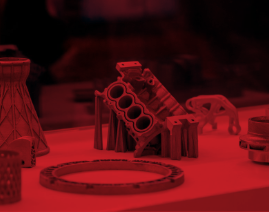

Every year, as the technology improves and expands, more and more 3D printing materials are introduced to the market. With so many options, it can be overwhelming to know which ones are worth utilizing and which ones are just a fad. Additionally, it can become even more challenging to know in which circumstances or for which products each material is best suited.
To help you make a well-informed decision, we have put together a list of the four most exciting 3D printing materials in 2020. Keep reading to learn more.
For a long time, plastics have been the most commonly used material for 3D printing as they provide a wide variety of options with different specs that can be utilized for different purposes. That being said, PLA and ABS are two of the most popular plastics for many product development applications.
Polylactic acid (PLA)is derived from plant starches – which makes it one of the most affordable options – and is known for its ease of usage, ability to print excellent details, and its strong form. Additionally, PLA comes in an extensive rainbow of colors, which makes it ideal if you want 3D printing that has high visual appeal.
The advantages of acrylonitrile, butadiene, and styrene (ABS) include its ability to create functional prototypes, and its high mechanical strengths and high thermal resistance. Its durability and toughness are among the main reasons industries worldwide opt to use this material for their 3D printing needs.
Slightly more expensive than plastic, polyamide is an exciting material for professional 3D printing services due to its superior flexibility and strength.
Its strong bonding quality makes it ideal for parts that require mechanical strength. Because of its rough surface that can be developed in many ways (colored, polished, spray-painted, velvet glazed), polyamide tends to be the first choice for many fields including engineering and architecture, medicine, and in the arts (e.g., sculpture).
As this material works with FDM and SLS technologies, at Proto21, we believe it performs its best when applied to concept models, functional models, medical applications, tooling, and visual arts. Other advantages include the fact that it is chemical resistant, food safe, and has high thermal properties and low moisture absorption.
If you require a multicolored object, then you are going to be excited to hear about sandstone, which is the ultimate full-color 3D printing material.
Often used to create figurines, avatars, or to showcase models, sandstone 3D printing is achieved by adding one layer of color at a time. At Proto21, once the model has been printed, we finish it with cyanoacrylate (super glue) sealant to guarantee durability and to sustain the vivid colors.
For many people, having a 3D printed sandstone model on their desk is the most significant benefit of this material; however, there are other advantages as well such as the affordable pricing and fast turnaround time.
That being said, it is crucial to understand that this material is not suited for producing functional parts or daily handling; else, the colors will quickly fade.
One of the best choices for functional and concept models, resin is especially suited for the manufacture of large parts within a shorter period of time, while preserving a tremendous amount of detail.
As a photopolymer, the resin begins as a viscous liquid that is then turned into a solid by exposing it to UV light.
There are a number of different resins available, all of which are used for different applications. At Proto21, we offer six types of resin for 3D printing and rapid prototyping:
Has your business started utilizing the exciting technology of 3D printing? If so, what do you tend to get printed and which materials do you like to use?
Alternatively, if you haven’t tried it yet (and, therefore, aren’t aware of the myriad benefits it can bring to your company), what is stopping you?
Do you have any questions about 3D printing technology and materials as they apply to your business? We can help.
Get in touch with us today.
Pir Arkam is the founder & CEO of Proto21 a 3D Printing Service Catering across a wide range of industries manufacturing & prototyping solutions

3D Printing is already shaking our age-old notions of what can and can’t be made.
- Hod Lipson
Proto21 | ©2022 All rights reserved | Powered by Salsoft Technologies
Your Local Manufacturing Partner

Enter your information below and our team will reach out to you shortly.
This will close in 0 seconds